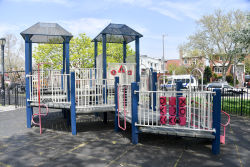Dyker Beach Park
Dyker Beach Playground
Dyker Beach Playground, located within Dyker Beach Park, is a popular gathering place for the Dyker Heights community. As early as 1639, Dutch settlers bought land from the Canarsee Indians in the neighborhood now known as Dyker Heights. By 1657 the area was annexed as part of New Utrecht, one of the six original Dutch towns that later joined to form the City (now borough) of Brooklyn. Waves of immigrants made their homes here – in the 19th century from Scandinavia, from Ireland and Italy in the early 20th century, and from China, Italy, and the former Soviet Union in more recent years.
The area was not developed as a residential neighborhood until the early 20th century, at which time it took its name, Dyker Heights. Block after block of one- and two-family houses were constructed, and land developers named the area after nearby Dyker Park and Dyker Beach. There are two differing stories concerning how these Brooklyn places got their names. The namesake may have been the Van Dykes who helped to divide the land when it was part of the Dutch town of New Utrecht. Alternatively, the name may reflect the dikes that the Dutch settlers used to drain and reclaim the marshy land.
The park was assembled from 8 pieces of land over the course of 40 years. In 1895 the City of Brooklyn purchased the first parcel from the Dyker Meadow Land Improvement Company for a park. The landscape architecture firm of Olmsted, Olmsted & Eliot planned a 50-acre saltwater lagoon, children’s playgrounds, bathhouses, lawns, and drives along the shore. The 1896 Annual Report of the Brooklyn Parks Department claimed that Dyker would be the “finest seaside park in the world.”
Although a portion of the site was used by the Dyker Meadow Golf Club, development of the remainder proceeded slowly. Bathhouses and roads were erected, and the plans were revised somewhat in 1911 by Charles D. Lay, former landscape architect of the Park Board. He proposed to decrease the size of the lagoon to 16 acres and add several concert groves. In 1918 work began to fill a swampy area of the park. Four additional parcels were acquired between 1924 and 1927 by assignment and condemnation. Another three lots were transferred to Parks in 1934.
Several sites within Dyker Beach Park are named for local leaders. Kimberly Cassas Walk and Anthony Mosomillo Memorial Courts are named for slain police officers. The southern portion of the property, Ben Vitale Ballfields, is named for a physical education teacher, and one of the ballfields takes its name from Joe Torregrossa Jr. and John Caiazza, leaders of the St. Bernadette’s Athletic Association. The park also features gardens planted by local students, community organizations, and merchants.
Reconstruction projects at this and the other playground in Dyker Beach Park were funded by former Council Member John A. Fusco at a total cost of $785,000. This site was provided with new play equipment decorated with dolphins, safety surfacing, pavement, curbs, fencing, game tables, benches, and north arrow compass rosette. Also included in the playground are drinking fountains, a public restroom decorated with dog shadows, a yardarm, lampposts, swing sets, picnic tables, a spray shower, four handball courts, two boccie courts, and a paved baseball field.
Check out your park's Vital Signs
Clean & Safe
Green & Resilient
Empowered & Engaged Users
Share your feedback or learn more about how this park is part of a
Vital Park System










